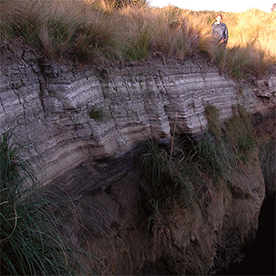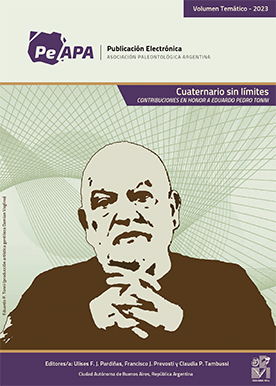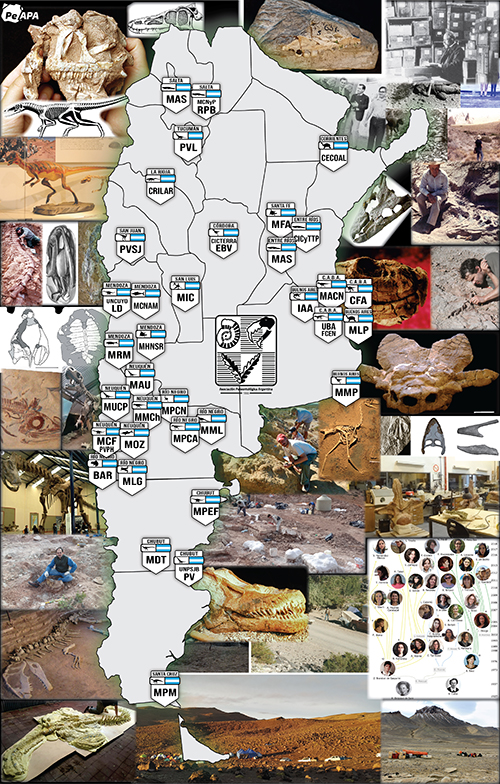ANÁLISIS E INTERPRETACIÓN DE REGISTROS PALINOLÓGICOS DE SUCESIONES ALUVIALES DE LA REGIÓN PAMPEANA: REVISIÓN E IMPLICANCIAS PARA LA RECONSTRUCCIÓN DE LA VEGETACIÓN Y EL CLIMA DURANTE EL PLEISTOCENO TARDIO - HOLOCENO
DOI:
https://doi.org/10.5710/PEAPA.27.09.2016.114Abstract
En este trabajo se sintetizan y discuten los resultados de ca. 30 años de estudios palinológicos de depósitos aluviales del Pleistoceno Tardío-Holoceno de la región pampeana (RP). La mayor parte de las reconstrucciones de la vegetación para ese lapso han derivado del análisis polínico de depósitos aluviales, aunque en ciertos casos los resultados son controvertidos. La presente revisión muestra que el análisis palinológico de sucesiones aluviales es un recurso importante de información paleoambiental cuali y cuantitativa para la RP, pero también expone que no todas las secuencias polínicas publicadas son adecuadas para hacer reconstrucciones de la vegetación y el clima. Las principales causas de discrepancias entre los resultados han sido el escaso entendimiento sobre el transporte fluvial del polen, la preservación polínica y la tafonomía y el control de las facies sedimentarias en las posibles modificaciones de los registros polínicos. Las causas de la alteración de los conjuntos polínicos, aunque relacionadas principalmente con repetidos ciclos de hidratación-desecación, degradación microbiana y posible control de facies, han sido escasamente discutidas en la mayoría de los trabajos. Esto señala la necesidad de realizar estudios sobre la preservación polínica diferencial y la cuantificación del polen transportado por los ríos, poniendo más atención en el conocimiento de los procesos tafonómicos para mejorar la interpretación de los registros palinológicos fósiles. A pesar de esto, los progresos realizados recientemente han permitido lograr reconstrucciones significativamente más precisas e informativas de la vegetación y del clima del pasado en la RP que lo que fue posible anteriormente.
PALABARS CLAVE. Palinología fluvial. Tafonomía. Preservación polínica. Argentina.
Abstract. ANALYSES AND INTERPRETATION OF PALYNOLOGICAL RECORDS FROM ALLUVIAL SEQUENCES OF THE PAMPAS REGION: REVIEW AND IMPLICATIONS FOR VEGETATATION AND CLIMATE RECONSTRUCTION DURING THE LATE PLEISTOCENE - HOLOCENE. In this review the results of Late Pleistocene-Holocene palynological studies from alluvial deposits in the Pampas region (PR) performed over the last ca. 30 years have been synthesized and discussed. Most vegetation reconstructions for that period have been derived from pollen analysis of alluvial deposits, although in some cases the results are controversial. The present review shows that palynological analysis from alluvial sequences is an important resource of qualitative and quantitative paleoenvironmental information for the PR, but also states that not all published pollen records are suitable for vegetation and climate reconstructions. The main causes of discrepancies between the results are the limited understanding of pollen fluvial transport, pollen preservation and taphonomy and sedimentary facies control that could have altered the pollen records. The causes of the alteration of the pollen assemblages, although mainly related to repeated wetting-drying cycles, microbial degradation and possible control of facies, have scarcely been discussed in most works. This points the need for studies on differential pollen preservation and quantification of pollen transported by river water, paying more attention to the knowledge of taphonomic processes to improve the interpretation of fossil palynological records. Even so, the progress achieved recently have made possible to obtain significantly more precise and informative reconstructions of past vegetation and climate in the PR than was possible earlier.
KEY WORDS. Fluvial palynology. Taphonomy. Pollen preservation. Argentina.
References
Albert, B.M. y Pokorný, P., 2012. Pollen taphonomy and hydrology at Vranský potok versus Zahájí alluvial pollen sites: Methodological implications for cultural landscape reconstruction in the Peruc Sandstone Area, Czech Republic. Interdisciplinaria archaeological. Natural Sciences in Archaeology 3 (1): 85–101.
Baker, R.G., Fredlund, G.G, Mandel, R.D. y Bettis III, E.A. 2000. Holocene environments of the central Great Plains: multi-proxy evidence from alluvial sequences, southeastern Nebraska. Quaternary International 67: 75–88.
Berman, A.L., Silvestri, G.E., Rojas, M. y Tonello, M.S. 2016. Accelerated greenhouse gases versus slow insolation forcing induced climate changes in southern South America since the Mid‑Holocene. Climate Dynamics DOI 10.1007/s00382-016-3081-z.
Bisernia, G. y van Geel, B. 2005. Reconstruction of Holocene palaeoenvironment and sedimentation history of the Ombrone alluvial plain (South Tuscany, Italy). Review of Palaeobotany and Palynology 136: 16–28.
Borel, C.M. 2007. Algas no silíceas y acritarcos de depósitos costeros holocenos en el Arroyo La Ballenera, Buenos Aires, Argentina. Ameghiniana 44(2):359–366.
Borel, C.M., Bianchinotti, M.V. y Quattrocchio, M.E. 2001. Palinomofos fúgicos del Pleistoceno-Holoceno en el valle del Arroyo Chasicó, provincia de Buenos Aires, Argentina. Polen 11:21–37.
Borromei, A.M. 1995. Palinología, estratigrafía y paleoambientes del Pleistoceno tardío-Holoceno en el valle del río Sauce Grande, provincia de Buenos Aires. Polen 7:19–31.
Borromei, A.M. 1998. Vegetación y clima del Cuaternario tardío en el valle superior del Río Sauce Grande, Provincia de Buenos Aires, Argentina. Polen 9:5–15.
Brown, A.G. 1985. The potential use of pollen in the identification of suspended sediment sources. Earth Surface Processes Landforms 10: 27–32.
Brown, A. G., R. G. Carpenter y Walling, D. E. 2007. Monitoring fluvial pollen transport, its relationship to catchment vegetation and implications for palaeoenvironmental studies. Review of Palaeobotany and Palynology 147: 60–76.
Brown, A.G., R.G. Carpenter y Walling, D.E. 2008. Monitoring the fluvial palynomorph load in a lowland temperate catchment and its relationship to suspended sediment and discharge. Hydrobiologia 607:27–40
Brush, G.S. y Brush, L.M. Jr. 1972. Transport of pollen in a sediment-laden channel, a laboratory study. American Journal of Science 272: 359–381.
Bryant, V.M., Jr., Holloway, R.G. 1983. The role of palynology in archaeology Advances in archaeological method and theory 6: 191–224.
Bryant, V.M., Jr., Holloway, R.G. Jones, J.G y Carlson, D.L. 1994. Pollen preservation in alkaline soils of the American Southwest. En: A. Traverse (Ed.), Sedimentation of organic particles. Cambridge University Press, p. 47–58.
Bunting, M.J. y Tipping, R. 2000. Sorting dross from data: possible indicators of post depositational assemblafe viasing in archaeological palynology. En: G. Bailey, N. Winder y R. Charles (Eds.), Human Ecodynamics. Oxbox Books, Oxford, p. 63–68.
Campbell, I.D. 1991. Experimental mechanical destruction of pollen grains. Palynology 15: 29–33.
Campbell, I.D. y Campbell, C. 1994. Pollen preservation: experimental wet-dry cycles in saline and desalinated sediments. Palynology 18: 5–10.
Campbell, I.D. y Chmura, G.L. 1994. Pollen distribution in the Atchafalaya River, U.S.A. Palynology 18: 55–65.
Catto, N.R. 1985. Hydrodynamic distribution of palynomorphs in a fluvial succession, Yukon. Canadian Journal of Earth Science 22: 1552–1556.
Chmura, G.L. y Liu, K.B. 1990. Pollen in the lower Mississippi River. Review of Palaeobotany and Palynology 64: 253–261.
Chmura, G.L., Smirnov, A. y Campbell, I.D. 1999. Pollen transport through distributaries and depositional patterns in coastal waters. Palaeogeography, Palaeoclimatology, Palaeoecology 149: 257–270.
Cushing, E.J. 1967. Evidence for differential pollen preservation in Late Quaternary sediments in Minnesota. Review of Palaeobotany and Palynology 4: 87–101.
D’Antoni, H.L., Nieto, M.A. y Mancini, M.V. 1985. Pollen analytic stratigraphy of Arroyo Las Brusquitas profile (Buenos Aires Province, Argentina). Zentralblatt fuer Geologie and Palaeontologie 1: 1721–1729.
Delcourt, P.A. y Delcourt, H.R., 1980. Pollen preservation and quaternary environmental history in the Southeastern United States. Palynology 4 (1): 215–231.
Delcourt, P.A., Delcourt, H.R., .Brister, D.C. y Lackey, L.E., 1980. Quaternary vegetation history of the Mississippi embayment. Quaternary Research 13: 111–132.
Dimbleby, G.W. 1957. Pollen analysis of terrestrial soils. New Phytologist 56: 12–28.
Dimbleby, G.W. 1985. The palynology of archaeological sites. Academic Press, Inc., 176 p.
Fall, P.L. 1987. Pollen taphonomy in a canyon stream. Quaternary Research 28: 393–406.
Elsik, W.C, 1971. Microbial degradation of spopollenin. En: P. Brooks, R. Grant y M. Muir (Eds.), Sporopollenin. Proceeding of a Symposium at the Geological Department, Imperial College, London p. 480–510.
Fægri K, Iversen J. 1989. Textbook of Pollen Analysis. New York, John Wiley & Sons. 328 pp.
Fidalgo, F., De Francesco, F., Colado, U., 1973. Geología superficial de las hojas Castelli, J.M. Cobo y Monasterio, Provincia de Buenos Aires. 5º Congreso Geológico Argentino, 4: 27–39.
Fucks E.E., Schnack, E.J. y Aguirre, M.L. 2010. Nuevo ordenamiento estratigráfico de las secuencias marinas del sector continental de la bahía Samborombón, provincia de Buenos Aires. Revista de la Asociación Geológica Argentina 67: 27–39.
Grichuk, M.P. 1967. The study of pollen spectra from recent and ancient alluvium. Review of Palaeobotany and Palynology 4: 107–112.
Grill, S.C. 1995. Análisis palinológico de un perfil cuaternario en la cuenca media del arroyo Napostá Grande, Localidad García del Río, provincia de Buenos Aires. 4º Jornadas Geológicas Bonaerenses (Junín), Actas 1: 99–107.
Grill, S.C. 1997. Análisis palinológico de un perfil cuaternario en la cuenca media del arroyo Napostá Grande, provincia de Buenos Aires, Argentina. Implicancias paleoambientales. Polen 8: 23–40.
Grill, S.C. 2003. Análisis palinológico de sedimentos cuaternarios en la cuenca inferior del río Quequén Salado, provincia de Buenos Aires, Argentina. Polen 12: 37–52.
Grill, S., Borromei. A., Martínez G., Gutiérrez, M.A., Cornou, M.E. y Olivera, D. 2007. Palynofacial analysis in alkaline soils and paleoenvironmental implications: The Paso Otero 5 archaeological site (Necochea district, Buenos Aires province, Argentina). Journal of South American Earth Sciences 24: 34–47.
Gutiérrez, M.A., Martínez, G., Luchsinger, H., Grill, S., Zucol, A.F., Hassan, G.S., Barros, M.P., Kaufmann, C.A. y Álvarez, M.C. 2011. Paleoenvironments in the Paso Otero locality during Late Pleistocene-Holocene (Pampean region, Argentina): An interdisciplinary approach. Quaternary International 245: 37−47.
Hall, S.A. 1977. Late Quaternary sedimentation and paleoecologic history of Chaco Canyon, New Mexico. Geological Society of American Bulletin 88: 1593−1618.
Hall, S.A. 1981. Deteriorated pollen grains and the interpretation of Quaternary pollen diagrams. Review of Palaeobotany and Palynology 32: 193−206.
Hall, S.A. 1985. Quaternary pollen analysis and vegetational history of the southwest. En: V.M. Bryant Jr. y R.G. Holloway (Eds.), Pollen Records of Late Quaternary North American Sediments. American Association of Stratigraphic Palynologist Foundation, p. 95–124.
Hall, S.A. 1989. Pollen analysis and paleoecology of alluvium. Quaternary Research 31: 435-438.
Hall, S.A. 1995. Late Cenozoic palynology in the South-central United States: cases of post-depositional pollen destruction. Palynology 19: 85–93.
Hall, S.A. 2010. New interpretations of alluvial and paleovegetation records from Chaco Canyon, New Mexico. New Mexico Geological Society Guidebook, 61st Field Conference, Four Corners Country, p. 231–246.
Havinga, A.J. 1964. Investigation into the differential corrosion susceptibility of pollen and spores. Pollen et Spores 6 (2): 621–635.
Havinga, A.J. 1967 Palynology and pollen preservation. Review of Palaeobotany and Palynology 2 (1-4): 81–98.
Havinga, A.J. 1970. An experimental investigation into decay of pollen and spores in various soil types. En: P. Brooks, R. Grant y M. Muir (Eds.), Sporopollenin. Proceeding of a Symposium at the Geological Department, Imperial College, London p. 446–479.
Havinga, A.J. 1984. A 20-year experimental investigation into the differential corrosion susceptibility of pollen and spores in various soil types. Pollen et Spores 26 (3-4): 541–558.
Holloway, R.G. 1989. Experimental mechanical pollen degradation and its application to Quaternary age deposits. The Texas Journal of Science 41: 131–145.
Holmes, P.L. 1990. Differential transport of spores and pollen: A laboratory study. Review of Palaeobotany and Palynology 64: 289–296.
Horowitz, A. 1992. Palynology of arid lands. Elsevier, 546 p.
Johnson, E., Holliday, V.T., Martínez, G., Gutiérrez, M. y Politis, G. 2012. Geochronology and landscape development along the middle Río Quequén Grande at the Paso Otero Locality, Pampa Interserrana, Argentina. Geoarchaeology: An International Journal 27: 300–323.
Ma, Y., Zhang, H., Pachur, H.J., Wünnemann, B., Li, J. y Feng, Z., 2004. Modern pollen-based interpretations of mid-Holocene palaeoclimate (8500 to 3000 cal. BP) at the southern margin of the Tengger Desert, northwestern China. The Holocene 14 (6): 841–850.
Madrid, P. y Politis, G. 1991. Estudios paleoambientales en la región pampeana: un enfoque multidisciplinario: 9º Congreso Nacional de Arqueología Chilena (Santiago de Chile) Actas 1: 131–154.
Marchant, R., Harrison, S.P., Hooghiemstra, H., Markgraf, V., van Boxel, J.H., Ager, T., Almeida, L., Anderson, R., Baied, C., Behling, H., Berrio, J.C., Burbridge, R., Björck, S., Byrne, R., Bush, M.B., Cleef, A.M., Duivenvoorden, J.F., Flenley, J.R., De Oliveira, P., van Geel, B., Graf, K.J., Gosling, W.D., Harbele, S., van der Hammen, T., Hansen, B.C.S., Horn, S.P., Islebe, G.A., Kuhry, P., Ledru, M.P., Mayle, F.E., Leyden, B.W., Lozano-García, S., Melief, A.B.M., Moreno, P., Moar, N.T., Prieto, A., van Reenen, G.B., Salgado-Labouriau, M.L., Schäbitz, F., Schreve-Brinkman, E.J. y Wille, M. 2009. Pollen-based biome reconstructions for Latin America at 0, 6000 and 18,000 radiocarbon years. Climate of the Past 5 (4): 725-767
Martin, P. S. 1963. The last 10000 years: A fossil pollen record of the America Southwest. University of Arizona Press, Tucson, 87 p.
Mehringer, P.J. 1967. Pollen analysis and the alluvial chronology. Kiva, 32: 96–101.
Mehringer, P.J., Martin, P.S. y Haynes, C.V. 1967. Murray Springs, a mid-postglacial pollen record from southern Arizona: American Journal of Science 265: 786–797.
Moss, P.T., Kershaw, A.P. y Grindrod, J. 2005. Pollen transport and deposition in riverine and marine environments within the humid tropics of northeastern Australia. Review of Palaeobotany and Palynology 134: 55–69.
Prado, L.F., Wainer I., Chiessi, C.M., Ledru, M.-P. y Turcq, B. 2013. A mid-Holocene climate reconstruction for eastern South America. Climate of the Past 9: 2117–2133.
Prieto, A.R. 1989. Palinología de Empalme Querandíes (Provincia de Buenos Aires). Un modelo paleoambiental para el Pleistoceno tardío-Holoceno. Tesis Doctoral, Facultad de Ciencias Exactas y Naturales, Universidad Nacional de Mar del Plata, Mar del Plata, 207 p. Inédita..
Prieto, A.R. 1996. Late Quaternary vegetational and climatic changes in the Pampa grassland of Argentina. Quaternary Research 45: 73–88.
Prieto, A.R. 2000. Vegetational history of the Late glacial - Holocene transition in the grasslands of eastern Argentina. Palaeogeography, Palaeoclimatology, Palaeoecology 157 (3-4): 167–188.
Prieto, A.R. y Quattrocchio, M.E. 1993. Briofitas y pteridofitas en sedimentos del Holoceno de la Provincia de Buenos Aires, Argentina. Anales de la Asociación de Palinólogos de Lengua Española 6: 17–37.
Prieto, A.R., Vilanova, I. y De Francesco, C.G. 2003. Estratigrafía y paleoecología del Pleistoceno tardío-Holoceno del área del arroyo Las Brusquitas, Buenos Aires, Argentina: una revisión: En M. Collantes, J.M. Sayago y L. del V. Neder (Eds.) 2º Congreso Argentino de Cuaternario y Geomorfología, Cuaternario y Geomorfología (S.M. Tucumán) p. 47–56.
Prieto, A.R., Blasi, A.M., De Francesco, C.G. y Fernández, C. 2004. Environmental history since 11,000 yr B.P. of the northeastern Pampas, Argentina from alluvial sequences of Luján River. Quaternary Research 62(2):146–161.
Prieto, A.R., Vilanova, I., Tonello, M.S. y Stutz, S. 2009. Reconstrucción de la vegetación y del clima de los pastizales pampeanos durante el Pleistoceno tardío – Holoceno a través del análisis palinológico. Quaternário do Rio Grande do Sul: integrando conhecimentos. Monografias da Sociedade Brasileira de Paleontologia: 107–120.
Prieto, A.R., Romero M.V., Vilanova, I., Bettis III. E.A., Espinosa, M. A., Haj, A.E., Gómez, L. y Bruno, L.I. 2014. A multi-proxy study of Holocene environmental change from alluvial deposits, in the southern coast of the Pampa region, Argentina. Journal of Quaternary Science 29 (4): 329–342.
Quattrocchio, M.E., Grill, S.C. y Zavala, C.A. 1998. Chronostratigraphic and Palynozone chronosequences charts of Napostá Grande Creek, Southwestern Buenos Aires Province, Argentina. Quaternary of South America and Antarctic Peninsula 7: 111–133.
Quattrocchio, M.E., Borromei, A.M., Deschamps, C.M., Grill, S.C. y Zavala, C.A. 2008. Landscape evolution and climate changes in the Late Pleistocene-Holocene, southern Pampa (Argentina): Evidence from palynology, mammals and sedimentology. Quaternary International 181:123–138.
Rabassa, J. 1989. Geología de los depósitos del Pleistoceno Superior y Holoceno en las cabeceras del río Sauce Grande, provincia de Buenos Aires. 1º Jornadas Geológicas Bonaerense (1985) (Tandil). Actas: 765–790.
Rojo, L.D.; Mehl, A.E.; Paez, M.M. y Zárate, M.A. 2012. Mid- to Late Holocene pollen and alluvial record of the arid Andean piedmont between 33° and 34°S, Mendoza, Argentina: Inferences about floodplain evolution. Journal of Arid Environments 77: 110–122.
Seppä, H. y Bennett, K.D., 2003. Quaternary pollen analysis: recent progress in palaeoecology and palaeoclimatology. Progress in Physical Geography 27 (4): 548–579.
Smirnov, A., Chmura, G.L. y Lapointe, M.F. 1996. Spatial distribution of suspended pollen in the Mississippi River as an example of pollen transport in alluvial channels. Review of Palaeobotany and Palynology 92: 69–81.
Solomon, A. M., Blasing, T. J. y Solomon, J.A. 1982. Interpretation of floodplain pollen in alluvial sediments from an arid region. Quaternary Research 18: 52–71.
Stutz, S. y Prieto, A.R., 2003. Modern pollen and vegetation relationships in Mar Chiquita coastal lagoon area, southeastern Pampa grasslands, Argentina. Review of Palaeobotany and Palynology 126: 183–195.
Stutz, S, Prieto, A.R. e Isla, F.I. 1999. Cambios de la vegetación durante el Holoceno en el SE bonaerense: análisis polínico del paleoestuario del arroyo La Ballenera. Asociación Paleontológica Argentina, Publicación Especial 6: 65–69.
Stutz, S., C.M. Borel, S.L. Fontana y Tonello, M.S. 2012. Holocene evolution of three shallow lakes in the SE Pampa plain (Argentina) as evidenced by analyses of pollen, non-pollen palynomorphs and plant macrofossils.The Holocene 22: 1215-1222.
Stutz, S., Tonello M.S., González Sagrario, M A., Navarro, D. y Fontana, S.L. 2014. Historia ambiental de los lagos someros de la llanura Pampeana (Argentina) desde el Holoceno medio: Inferencias paleoclimáticas. Latin American journal of sedimentology and basin analysis 21 (2): 119-138.
Tipping, R. 2000. Pollen preservation analysis as a necessity in Holocene palynology. En: J.P. Huntley y S. Stallibrass (Eds.), Taphonomy and interpretation. Symposia of the Association of Environmental Archaeologist, 14. Oxbox Books, Oxford, p. 23–33.
Tonello, M. y Prieto, A.R., 2003. Relaciones cuantitativas polen-clima actual para el pastizal pampeano: primeros resultados. Revista del Museo Argentino de Ciencias Naturales. Nueva Serie 5 (2): 317–327.
Tonello, M.S y Prieto, A.R. 2008. Modern vegetation-pollen-climate relationships for the Pampa grasslands of Argentina. Journal of Biogeography 35(5): 926–938.
Tonello, M.S y Prieto, A.R. 2010. Tendencias climáticas para los pastizales pampeanos durante el Pleistoceno tardío-Holoceno: estimaciones cuantitativas basadas en secuencias polínicas fósiles. Ameghiniana 47 (4): 501–514.
Tonello, M.S., Zárate, M.A. y Mancini, M.V. 2002. Trazas radicales ferrosas en una secuencia aluvial del río Quequén Grande (Buenos Aires): implicancias estratigráficas y ambientales. Ameghiniana 39 (2):163–174.
Traverse, A. 1992. Organic fluvial sediment: palynomorphs and "palynodebris" in the lower Trinity River, Texas. Annals of the Missouri Botanical Garden 79: 110–125.
Tschudy, R.H. 1969. Relationship of palynomorphs to sedimentation. En R.H. Tschudy y R.A. Scott (Eds.). Aspects of palynology, p. 79–96.
Twiddle, C.L.y Bunting, M.J. 2010. Experimental investigations into the preservation of pollen grains: A pilot study of four pollen types. Review of Palaeobotany and Palynology 162: 621-630.
van Geel, B., 2001. Non-pollen palynomorphs: En: Smol, J.P., Birks, H.J.B., Last,W.M. (Eds.), Tracking Environmental Change Using Lake Sediments. Volumen 3: Terrestrial, Algal and Siliceous Indicators. Kluwer Academic Publishers, Dordrecht, The Netherlands: 99-120.
Vilanova, I. y Prieto, A.R. 2012. Historia de la vegetación de las llanuras costeras de la Bahía Samborombón ( 35,5° S), Argentina, desde 7800 14C años. Ameghiniana 49 (3): 303–318.
Vilanova, I., Prieto, A.R. y Espinosa, M.E., 2006. Paleoenvironmental evolution and sea-level fluctuations along the southeastern Pampa grasslands coast of Argentina during the Holocene. Journal of Quaternary Science 21(3): 227–242
Vilanova, I., Prieto, A.R., Stutz, S. y Bettis III, A. 2010. Holocene vegetation changes along the southeastern coast of the Argentinean Pampa grasslands in relation to sea-level fluctuations and climatic variability: palynological analysis of alluvial sequences from Arroyo Claromecó. Palaeogeography, Palaeoclimatology, Palaeoecology 298: 210–223.
Work, P.T., Semkenb, H.A. y Baker, R.G. 2005. Pollen, plant macrofossils and microvertebrates from mid-Holocene alluvium in east-central Iowa, USA: Comparative taphonomy and paleoecology. Palaeogeography, Palaeoclimatology, Palaeoecology 223 (3-4): 204–221.
Xu, Q., Yang, X., Wu, Ch., Meng, L.y Wang, Z. 1996. Alluvial pollen on the North China Plain. Quaternary Research 46: 270–280.
Zavala, C. y Quattrocchio, M. 2001. Estratigrafía y evolución geológica del río Sauce Grande (Cuaternario), provincia de Buenos Aires, Argentina. Revista de la Asociación Geológica Argentina 56 (1): 25–37.
Zárate, M.A. 2005. El Cenozoico tardío continental de la Provincia de Buenos Aires: En: R.E. de Barrio; P.O. Etcheverry; M.F. Caballé y Llambías, E. (Eds.), Geología y Recursos Naturales de la Provincia de Buenos Aires. 16º Congreso Geológico Argentino (La Plata) Relatorio: 139–158.
Zárate, M.A., Espinosa, M.A., Ferrero, L. 1998. Paleoenvironmental inplications of a Holocene diatomite, Pampa Interserrana, Argentina. Quaternary of South America and Antarctic Peninsula 11: 135–152.
Zárate, M.A., Kemp, R.A., Espinosa, M.A., Ferrero, L. 2000. Pedosedimentary and palaeoenvironmental significance of a Holocene alluvial sequence in the southern Pampas, Argentina. The Holocene 10 (4): 481–488.

Downloads
Published
Issue
Section
License
Copyright (c) 2016 Publicación Electrónica de la Asociación Paleontológica Argentina

This work is licensed under a Creative Commons Attribution-NoDerivatives 4.0 International License.

Authors retain copyright and grant the journal right of first publication with the work simultaneously licensed under a CC Attribution-NonCommercial 4.0 that allows others to share the work with an acknowledgement of the work's authorship and initial publication in this journal.






















